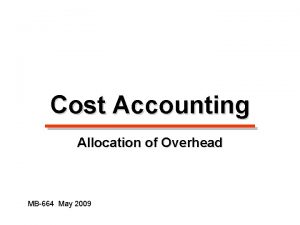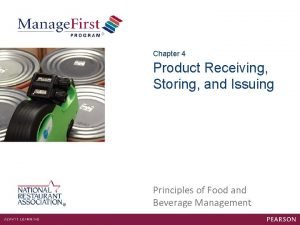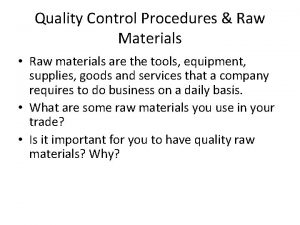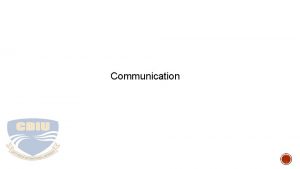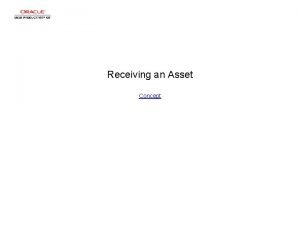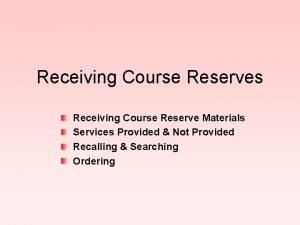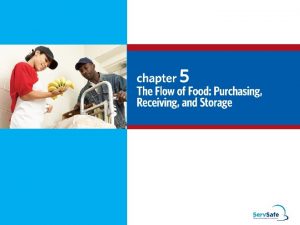COST CONTROL part 3 THE CONTROL PROCESS RECEIVING











- Slides: 11

COST CONTROL part 3 ---------------THE CONTROL PROCESS & RECEIVING

THE CONTROL PROCESS & RECEIVING • GOAL of Receiving Controls § Verify that Quality, Quantity and Price of delivered items conform to placed orders, in all respects. ü Quality ü requires & conforms to Purchasing Specifications ü Quantity Steward’s Market Quotation List ü requires measuring tools ü Price Steward’s Market Quotation List ü requires Purchase Order ü Over All Receiving Process ü requires recording using Forms and Stamps

Establishing Standards for Receiving 1. The quantity delivered should be the same as the quantity listed on the steward’s market quotation list, and this should match the quantity on the invoice that accompanies the delivery 2. The quality delivered should conform to the establishment’s standard purchase specification for that item 3. The prices on the invoice should match those circled on the steward’s market quotation list

Sample Invoice All food delivered should come with an Invoice in duplicate Lists all items being delivered & Should have ALL prices Receiving clerk signs duplicate copy-original serves as a “payable” bill If possible, encourage purveyor to also include item specs/grades/size/etc. Townsend Meats Buckeye Beef 312 -123 -4567 The Steak House Invoice 123 Main Street 22 Central Way IL 60601 New York, Chicago, New York, 10010 March 14

Std. Receiving Procedures for Foodservice Establishments (a generic template) 1. 2. 3 Verify that the quantity, quality, and price for each item delivered conforms exactly to the order placed Acknowledge that quantity, quality, and price have been verified by stamping the invoice with the rubber invoice stamp provided for that purpose List all invoices for foods delivered on a given day on the receiving clerk’s daily report for that day ü Directs / stores / Sundries / Details & Cost 4. 5. Forward completed paperwork to proper personnel Move food to appropriate storage areas ~ Procedure should include a Discrepancy Handling process ~ Delivery times should be controlled to suit purchaser-if possible ~ Chef/Kit. Mgr. MUST be Knowledgeable & Involved

STANDARD RECEIVING PROCEDURE To Complete the Verification Procedure • The Receiving Clerk needs the following ü a permanent copy of Standard Purchase Specifications § requires Knowledgeable Inspection of both raw materials and sanitation/HACCP regulations ü appropriate measuring equipment § hanging & platform scales ü appropriate forms / stamps / bar code reader, etc § important for accounting control follow-up Qualified employees who posses the vast amount of knowledge required are rare and therefore costly. Likewise, training beyond counting and weighing is a long-time investment. Consequently, the Chef is frequently called upon to be present when the perishables, meats seafood, poultry and expensive purchases are received.

The invoice stamp provides: 1. Verification of the date on which food was received 2. The signature of the clerk receiving the food who vouches for the accuracy of quantities, qualities, and prices 3. The steward’s signature, indicating that the steward knows that the food has been delivered 4. The food controller’s verification of the arithmetic accuracy of the bill 5. Signatory approval of the bill for payment by an authorized individual before a check is drawn

STANDARD RECEIVING PROCEDURE Listing Invoices on Receiving Clerk’s Daily Report Categories depends on how item is stored and issued • DIRECTS ü issued to kitchen upon receiving ü immediately become part of food cost ü very perishable items/bought for immediate use ü Fruits/vegs/dairy/baked goods/ (standing orders) • STORES ü not nearly as perishable ü once received - become Inventory ü issued to kitchen when requisitioned-then part of food cost ü Frozen items/canned items/staples/etc Smaller operations generally do not classify into categories. Example of a Cost/Benefit trade off: simplified receiving procedure (cheaper) vs. Reduces control --> isolating where cost problems exist is difficult.

STANDARD RECEIVING PROCEDURE Forwarding Completed Paperwork > From Receiving Clerk Completed as early as possible in the day Commonly called the ‘Receiving Sheet” Stamped & completed with all invoices attached > To Steward Reviews and signs invoices > To Food Controller Records total cost of directs to the daily Food Cost Reviews dollar accuracy of each invoice ØTo Accounting (accounts payable) Figures will be journalized (account distribution)

STANDARD RECEIVING PROCEDURE Receiving Clerk’s Report

STANDARD RECEIVING PROCEDURE Move to Storage all Received F&B Much effort has expense has been expended to this point • move to appropriate storage area ü prevent deterioration & theft ü most perishable &/or expensive first • Purpose for establishing receiving control procedures is to --> Ø Ensure what was ordered is received Ø Quality / Quantity / Price Ø All foodservice operations should practice these basic steps
 An ordering and receiving materials cost pool
An ordering and receiving materials cost pool Job order cost system
Job order cost system Product issuing
Product issuing Quality control of raw materials in food production
Quality control of raw materials in food production It means of sending or receiving information
It means of sending or receiving information A process of receiving selecting organizing
A process of receiving selecting organizing Dennis geyer
Dennis geyer Cost control and cost reduction difference
Cost control and cost reduction difference Cost control and cost reduction project report
Cost control and cost reduction project report Cost control and cost reduction project report
Cost control and cost reduction project report Product control and process control
Product control and process control Cost accumulation and cost assignment
Cost accumulation and cost assignment
